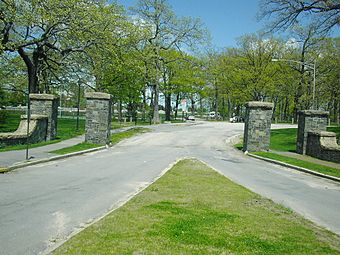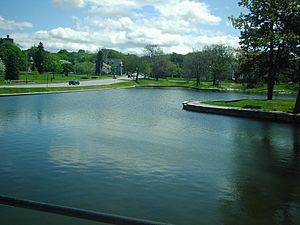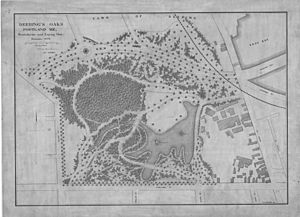Deering Oaks facts for kids
Quick facts for kids |
|
|
Deering Oaks
|
|

Entrance to Deering Oaks from Deering Avenue
|
|
| Location | Portland, Maine |
|---|---|
| Area | 42.71 acres (17.28 ha) |
| Built | 1879 |
| Architect | William A. Goodwin; Olmsted Brothers |
| NRHP reference No. | 89001708 |
| Added to NRHP | October 16, 1989 |
Deering Oaks is a big public park in Portland, Maine. It covers about 55 acres, which is like 40 football fields! The park has a baseball field, tennis courts, a playground, and a pond. It's a great place for families and friends to hang out. You can find it west of downtown Portland, surrounded by streets like Deering Avenue and Forest Avenue. The Portland Farmers Market is also held here. Deering Oaks is so special that it's listed on the National Register of Historic Places.
Contents
Park History: From Old Battles to a City Park
Deering Oaks has a long and interesting past. Long ago, in September 1689, during a time called King William's War, a brave person named Benjamin Church helped protect British settlers right here. They were defending themselves against people from New France and local Native American tribes.
Later, in the 1800s, the city of Portland wanted to make this land into a park. The land belonged to the Deering family. In 1875, the Deerings offered to give about 50 acres of their land to the city. In return, the city agreed to lower their taxes. This deal was made in 1879, and that's when Deering Oaks officially became a city park.
The park was designed by William Goodwin, who was the city's civil engineer. He worked with ideas from a famous park designer named Frederick Law Olmsted. Most of Goodwin's original park design is still here today. The only big change was when a small part of the park was used to build Interstate 295.
The pond in Deering Oaks used to be connected to the ocean! It would fill and empty with the tides. But this changed in the late 1800s when roads were built. The park also has a special statue called "The Hiker" by Theo Alice Ruggles Kitson. It honors soldiers from the Spanish–American War. In winter, you can go ice skating on the frozen pond.
In 2010, Deering Oaks was the site of a very large public gathering. Many people came to support a change in a military rule. A famous singer, Lady Gaga, even spoke at this event, which brought together about 2,000 people.
Park Improvements: Making Deering Oaks Even Better
Over the years, many efforts have been made to improve Deering Oaks. In 1994, the city council approved a big plan to make the park better. This plan included making some roads into walkways and improving sports areas. By 2004, the city had spent a lot of money on upgrades. These included building a children's wading pool and making the tennis courts better.
The Bridge Over Deering Oaks Ravine
In 1911, a beautiful arched footbridge was built over a small valley in Deering Oaks. It was 40 feet long and cost the city $3,355. This new bridge replaced an older wooden one. It even had tall glass lamps on both sides!
In 2010, work began to clean and repair this historic bridge. The city also planned to add new street lamps that look like the old ones. These new lights are made of strong plastic, not glass, to prevent damage.
Castle-in-the-Park: A Cozy Spot for Skaters
Deering Oaks has a special building called the Castle-in-the-Park. It was built in 1894 next to the pond. Its first purpose was to be a warm place for ice skaters to rest.
In 2004, people worked to restore the castle to its original Victorian style. Before that, it had been used as public bathrooms for about 50 years. A group called "Friends of Deering Oaks" helped raise money for this project.
Deering Oaks Pond: A Movie Star and a Big Project
Did you know Deering Oaks Pond was once in a movie? In 1996, it was used for an ice skating scene in the film "The Preacher's Wife." This movie starred famous actors Whitney Houston and Denzel Washington. About 150 crew members worked there, and 140 local people were chosen to be extras. They skated, walked, and even had snowball fights in the background to make the scene look like a busy Christmas in a park.
In 2010, Portland received a large grant to improve the pond. The project aimed to make the water cleaner. Sometimes, too much algae would grow in the summer, which harmed the water quality. The plan was to line the bottom of the pond with cement. This would help prevent algae blooms and protect the pond's structure.




